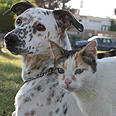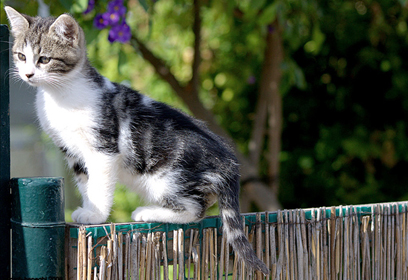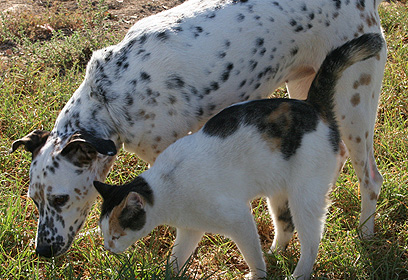
Enemies, a love story: Dogs and cats under the same roof
While many people are deterred by notion of raising dog and cat together, study shows that both species tend to be friendly towards one another, learn to understand each other's body language when sharing the same home
Raising dogs and cats under a shared roof is a comparatively new trend in Israel, apparently due to the common view that the two species are incompatible by nature, stemming from their separate evolutionary development. Consequently, many people considering the possible adoption of both species are concerned about their ability to get along.
A better understanding of aspects concerning the nature of relationships between dogs and cats could help in improving the welfare of those animals that dwell under a shared roof, and contribute to increasing the adoption numbers of animals in shelters.
Though both dogs and cats belong to the order Carnivora, whose members are renowned for their aggressive and efficient hunting abilities, the two species differ greatly in their social behavior. Unlike dogs and their closest relatives, which are social creatures that live and hunt as a pack, cats come from an entirely different group whose members are mostly solitary hunters and are considered to be asocial.

Social creatures (Photo: Baruch Feigenbaum)
Both species communicate via visual, olfactory and auditory channels, as well as physical contact, and show a high ability for observational learning. Their visual communication methods are expressed mainly by means of body language in relation to dominance status, aggression and fear. Although in many cases both dogs and cats employ a universal body language whose meaning among different mammals is generally similar and comprehensible, they also display a variety of signs that are unique to their particular species. And, in some cases, the same body language may be interpreted differently by dogs and cats.
There is a general belief that interspecific communication between dogs and cats is complicated, stemming from their separate evolutionary development, their different domestication processes and the lack of an innate ability to understand each other’s communications.
Although many studies have explored the relationships between human and dog as well as between human and cat, no studies have examined the nature of the relationships and the interactive behavior between dogs and cats living in the same house. Such studies can provide valuable information concerning development of the interspecific relationship and communicative behavior of the two species, and expand our knowledge regarding the role of the social environment provided by humankind in their pets’ lives.

Solitary hunters (Photo: Baruch Feigenbaum)
Interrelationships of dogs and cats living together were studied here in an attempt to determine the main factors influencing the type of relationship likely to develop between the two species. The study included 170 questionnaires completed by owners of both dog(s) and cat and 45 observations carried out in participants’ homes on their dog–cat interactions. Three possible relationships were established: amicable, aggressive, and indifferent, in order to evaluate the nature of the two species’ relationship.
It was found that the majority of dogs and cats (66%) revealed a similar mutual amicability, while aggression was rarely displayed (8%-9%).
In this study we also examined various factors that may affect the quality of the relationship between dogs and cats, including age of adoption, adoption order, gender and neutering.
Age of adoption
It is widely accepted that the socialization period, which is considered to be the critical period for acquiring social skills, takes place between the third and ninth week of both dogs’ and cats’ life. Accordingly, we examined whether the first encounter between dogs and cats during the socialization period contributes to the quality of their relationship.
It was found that if the dog is younger than one year upon its first encounter with the cat, the percentage of amicability is significantly higher, while aggression or indifference are significantly lower. The same tendency was shown in cats, but with the cut-off age of meeting being 6 months for the cat rather than a year.
Adoption order
Territorial behavior is defined as an aggressive behavior that enables an animal to control its territory, by preventing the entrance of alien individuals. Territorial behavior is often seen in dogs and cats, and it can develop into a behavioral problem. Adoption of a dog or cat into a home already possessing the other species might be perceived as territorial invasion. Accordingly, we examined the effect of the order of adoption on the nature of their relationship.

Friends forever (Photo: Baruch Feigenbaum)
The percentage of dogs exhibiting amicability was significantly higher in homes in which the cat had been adopted first, compared with those in which the dog was adopted first (75% vs 59%); while the percentage of indifference exhibited by such dogs (adopted first) was significantly lower (18% vs 32%). According to these findings there was no correlation between order of adoption and the behavior of the cat towards the dog.
Gender
It is widely accepted that, for most mammals, the male is the more aggressive gender. In addition, according to current research, neutering has a differential affect on the two genders and also affects different species differently. Therefore, we examined whether a correlation exists between the two species’ gender or neutering and their interrelationship. Female cats exhibited a higher level of aggression and indifference compared with male cats and a lower level of amicability towards dogs.
Neutering
It was found that intact dogs initiated contact more than neutered dogs, and neutered cats exhibited higher fear levels than intact cats. No correlation was found between gender, neutering, and additional behaviors of dogs and cats.
Communication
The final part of the study investigated whether a mutual understanding of body language exists between dogs and cats sharing the same accommodation. In most cases, both dogs and cats employ a universal body language whose meaning among the different mammals is generally similar and comprehensible. For instance: a direct stare indicates dominance. Nonetheless, in some cases the same body language may be interpreted differently by dogs and cats. For instance, the behavior “stretching out the forefeet”, is displayed/interpreted by dogs as friendliness or submission, whereas cats display/interpret it as aggression.
In order to establish whether a mutual understanding of body language is arrived at between dogs and cats dwelling under the same roof, we examined the reactions of both to each of the behaviors that have an opposite meaning for the other species. . It was found that the majority of behaviors that have an opposite meaning in dogs and cats were in fact read significantly correctly by both species (75% in dogs and 80% in cats). Furthermore, it seems that the ability to understand the other’s body language exists equally in dogs and cats, and there is a clear correlation between understanding the other’s body language and age of the first encounter between the two species. The results show that the closer the age of first encounter between dogs and cats is to the socialization period (up to 6 months), the better their understanding develops of the other’s body language.
Coexistence
The present study is the first to examine various aspects concerning the nature of relationships between dogs and cats sharing the same accommodation. The findings provide applicable knowledge regarding the welfare of dogs and cats sharing man's home: In order to encourage a positive relationship between the two species it is recommended to introduce them during the period of socialization age (up to 6 months of age in cats and up to one year in dogs). Additionally, if their adoption does not take place simultaneously, the cat should be adopted first and only afterward the dog.
Through adding the presence of a dog to a sole cat in the house, the cat’s quality of life can be improved; and willingness to adopt a dog from an animal shelter, when there is already a cat in the home, will prevent the euthanasia of many dogs that results from lack of shelter space.
"Interrelationships of dogs and cats living under the same roof," Neta-li Feuerstein, Joseph Terkel, Department of Zoology, The George S. Wise Faculty of Life Sciences, Tel Aviv University, Israel
The full article was published in Animals and Society
To contact Animals and Society: [email protected]










